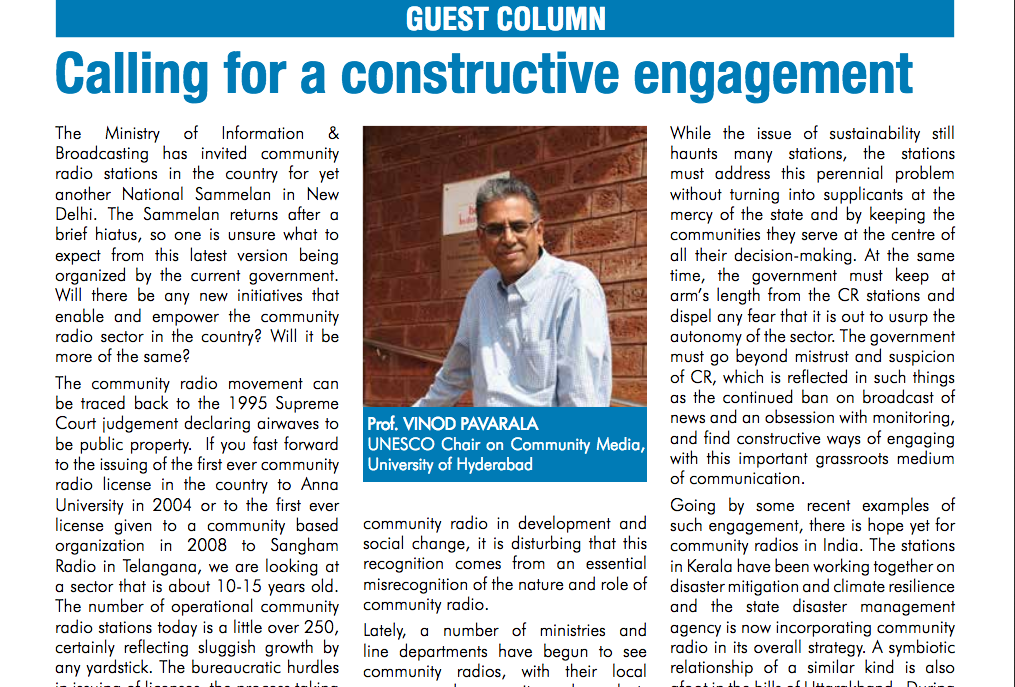From FSC desk (with accompanying note by Prof Vinod Pavarala):
“Community Radio Stations act as essential communication channels for enhancing last mile of outreach of government.” This was the astounding claim made in a PIB press release dated Sept 13, 2019:
118 new Community Radio Stations to be set-up

Whatever happened to the notion that community radio (CR) stations was about the Community? As it is, this government has taken our ‘public’ broadcasters – Doordarshan and All India Radio to the next level of sarkari mouthpieces. Both are suffused with Mann ki Baats and government programming.
In January this year, the BJP-led NDA government announced that private FM radio stations can broadcast AIR news bulletins in English and Hindi. Private FM stations were also told that they could air Prime Minister Narendra Modi’s Mann ki Baat programme, though this report, based on RTI information, says that the takers for it reduced each year:
There were no takers for the Prime Minister’s much-hyped monthly radio address in many BJP-ruled states, reveals an RTI reply.
So that leaves CR. The vibrant group of community radio practitioners have been raising the demand for the right to broadcast news on community radio for several years but this has literally fallen on deaf ears! The government’s argument has been that allowing news on community radio is dangerous and is a national security issue! The current batch of licences are to be issued includes areas the government designates as ‘left wing extremism designated districts’ so the minister’s statement that CRs enhance last mile connectivity for the government’s outreach is not doublespeak, but plainspeak!
In order to better undestand the implications of this, FSC republishes an important note by Prof. VINOD PAVARALA, reputed academic and UNESCO Chair on Community Media, University of Hyderabad :
The newsletter can be accessed here
Calling for a constructive engagement
The Ministry of Information & Broadcasting has invited community radio stations in the country for yet another National Sammelan in New Delhi. The Sammelan returns after a brief hiatus, so one is unsure what to expect from this latest version being organized by the current government. Will there be any new initiatives that enable and empower the community radio sector in the country? Will it be more of the same?

The community radio movement can be traced back to the 1995 Supreme Court judgement declaring airwaves to be public property. If you fast forward to the issuing of the first ever community radio license in the country to Anna University in 2004 or to the first ever license given to a community based organization in 2008 to Sangham Radio in Telangana, we are looking at a sector that is about 10-15 years old. The number of operational community radio stations today is a little over 250, certainly reflecting sluggish growth by any yardstick. The bureaucratic hurdles in issuing of licenses, the process taking anywhere upwards of a year, have been a huge deterrent.
As in any field, as the numbers have slowly increased, we see a full diversity of CR stations out there, run by a mélange of actors – schools, colleges, and universities, agricultural universities and research centres, and NGOs – which is only getting more and more interesting. There has been talk of state governments and the army wanting to establish community radio stations. Most recently one has heard of a NITI Aayog plan to help set up more than a hundred CR stations in the so-called ‘aspirational districts’ across the country. This in itself should be good news, right? I am not so sure. If one goes by the worldwide understanding of community radio, it is supposed to be third-sector broadcasting, outside of the state and the market. While one could feel gratified that the government now recognizes the potential of community radio in development and social change, it is disturbing that this recognition comes from an essential misrecognition of the nature and role of community radio.
Lately, a number of ministries and line departments have begun to see community radios, with their local presence and community reach, as a last-mile delivery platform for propagating government programmes and schemes. Citizens certainly have a right to know about what the government is doing for them, but community radio is not a one-way (top-down) dissemination arm of the government. Some of the wonderful examples of community radio in practice over the last decade in India, whether it is stations in the Gurgaon and Mewat areas of Haryana addressing issues of deprivation, migration, and reproductive health or stations in Odisha, Uttarakhand, and Kerala rising to the challenge of disaster mitigation in the face of natural calamities, have all provided demonstrable experiences of participatory communication and community engagement at the grassroots. We need an enlightened government to understand this character of community radio and find innovative and non-intrusive ways of supporting the sector.
While the issue of sustainability still haunts many stations, the stations must address this perennial problem without turning into supplicants at the mercy of the state and by keeping the communities they serve at the centre of all their decision-making. At the same time, the government must keep at arm’s length from the CR stations and dispel any fear that it is out to usurp the autonomy of the sector. The government must go beyond mistrust and suspicion of CR, which is reflected in such things as the continued ban on broadcast of news and an obsession with monitoring, and find constructive ways of engaging with this important grassroots medium of communication.
Going by some recent examples of such engagement, there is hope yet for community radios in India. The stations in Kerala have been working together on disaster mitigation and climate resilience and the state disaster management agency is now incorporating community radio in its overall strategy. A symbiotic relationship of a similar kind is also afoot in the hills of Uttarakhand. During the last general elections, the Election Commission of India, for the first time, engaged with scores of community radio stations across the country and gave them the freedom to do decentralized programming and community outreach in at least 20 different languages.
It is in the hope of such constructive engagement between the government and the community radio sector, while fully respecting its true character and autonomy, that I wish a productive Sammelan for all stations attending it this year.
(Prof Pavarala wrote the above as a Guest Column in the Newsletter of the Community Radio Association on the occasion of the seventh National Community Radio Sammelan in New Delhi on 27–29 Aug 2019)


